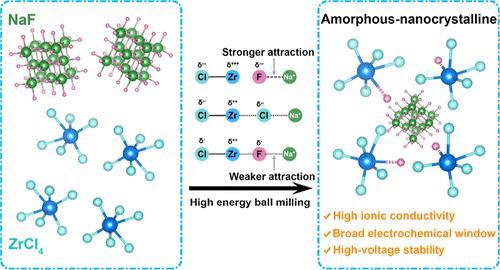具有高离子电导率和高电压稳定性的非晶纳米氟化卤化物电解质
IF 15.6
1区 化学
Q1 CHEMISTRY, MULTIDISCIPLINARY
引用次数: 0
摘要
全固态钠离子电池(assibs)为可充电锂离子电池提供了一种经济、可扩展的替代品,但它们的发展需要具有高离子电导率、广泛的电化学稳定性和强大的界面兼容性的固体电解质。本文制备了一种含氟卤化物固体电解质(2naf - zrcl4,2 - nfzc),该电解质具有非晶纳米晶结构,具有高离子电导率(25℃时为2.35 × 10-4 S cm-1)和良好的高压稳定性。2-NFZC中氟的掺入促进了Zr-F成键,限制了Na-F相互作用,促进了na离子通过无序区和NaF/非晶相界面的快速传输。与NaNi1/3Fe1/3Mn1/3O2阴极、Na15Sn4阳极和Na3PS4阳极夹层配合,2-NFZC电解质的全固态电池放电容量为137.1 mAh g-1,循环600次后容量保持率为81.1%,并抑制了界面副反应。这些发现突出了氟掺杂在设计高性能全固态钠离子电池的先进固体电解质方面的潜力。本文章由计算机程序翻译,如有差异,请以英文原文为准。

Amorphous-Nanocrystalline Fluorinated Halide Electrolytes with High Ionic Conductivity and High-Voltage Stability
All-solid-state sodium-ion batteries (ASSSIBs) offer a cost-effective, scalable alternative to rechargeable lithium-ion batteries, but their advancement requires solid electrolytes with high ionic conductivity, wide electrochemical stability, and robust interfacial compatibility. Here, a fluorine-doped halide solid electrolyte (2NaF–ZrCl4, 2-NFZC) featuring an amorphous-nanocrystalline structure with high ionic conductivity (2.35 × 10–4 S cm–1 at 25 °C) and good high-voltage stability is presented. Fluorine doping in 2-NFZC promotes Zr–F bonding with limited Na–F interaction, which facilitates fast Na-ion transport through disordered regions and the NaF/amorphous phase interface. Paired with a NaNi1/3Fe1/3Mn1/3O2 cathode, a Na15Sn4 anode, and a Na3PS4 anode interlayer, the all-solid-state cell with the 2-NFZC electrolyte demonstrates a discharged capacity of 137.1 mAh g–1, 81.1% capacity retention over 600 cycles, and suppressed interfacial side reactions. These findings highlight the potential of fluorine doping in designing advanced solid electrolytes for high-performance all-solid-state Na-ion batteries.
求助全文
通过发布文献求助,成功后即可免费获取论文全文。
去求助
来源期刊
CiteScore
24.40
自引率
6.00%
发文量
2398
审稿时长
1.6 months
期刊介绍:
The flagship journal of the American Chemical Society, known as the Journal of the American Chemical Society (JACS), has been a prestigious publication since its establishment in 1879. It holds a preeminent position in the field of chemistry and related interdisciplinary sciences. JACS is committed to disseminating cutting-edge research papers, covering a wide range of topics, and encompasses approximately 19,000 pages of Articles, Communications, and Perspectives annually. With a weekly publication frequency, JACS plays a vital role in advancing the field of chemistry by providing essential research.

 求助内容:
求助内容: 应助结果提醒方式:
应助结果提醒方式:


